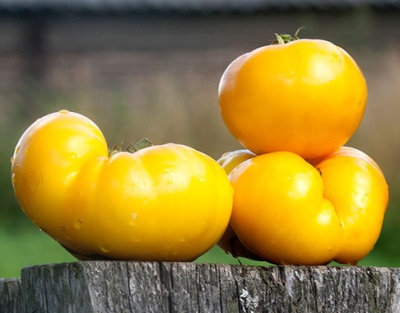
- Authors: Russia, Kazakhstan
- Name synonyms: Kazahstanskiy ghelty
- Category: grade
- Growth type: indeterminate
- Appointment: fresh consumption, for juice
- Ripening period: early
- Growing conditions: for open ground, for film greenhouses
- Bush size: tall
- Bush characteristic: strong
- Leaves: ordinary
Sweet crops are always very popular with gardeners. Due to their excellent taste, they are most often preserved for the winter. Kazakhstani yellow tomato belongs to such varieties.
Description of the variety
Culture is indeterminate. The stem is tall and grows up to 2 meters in height. The trunk is powerful and sturdy, with a little hairiness, green in color.
Leaves are medium, green, matte, with slight pubescence. There are large notches along the edging. The plate has veins and a median section. From severe drought or sun, the leaves roll inward.
Formation into 2 stems. The first ovary is at 6 or 7 leaves. Then every 2. Each cluster has 5-6 fruits.
Pros:
yield;
unpretentious care;
taste qualities;
immunity;
tolerance of not too long drought;
versatility.
Disadvantages:
pinning and garter;
crown formation.
The main qualities of the fruit
The berries are large, large. They are flat-round in shape. The first large tomatoes form on the lower branches. Their mass reaches 600-650 g. Subsequent vegetables will be smaller and weigh only from 200 to 500 g.
The skin is dense, glossy, elastic. Unripe tomatoes have a light green skin with small longitudinal green strokes. When the fruit is fully ripe, it turns yellow-orange without impurities.
The pulp is yellow, juicy, firm, sweet and not watery. Inside are small seed chambers. A peculiarity of the Kazakhstani yellow tomato is that the vegetable has a pink tie in the middle.
The variety is universal, therefore it is suitable for eating fresh, for making sauces, juices, tomato pastes, as well as canning and drying.
Taste characteristics
The variety Kazakhstani yellow has a sweet taste and a fruity aftertaste.
Ripening and fruiting
Early ripening variety - ripening period 110-120 days. Fruiting is extended, so the harvest begins in July and can continue until the first autumn frosts. On one hand, the buds are formed at the same time, like the ovaries, but the ripening of the fruits occurs at different times.
Yield
From 1 sq. meters can be removed from 10 to 12 kg of tomatoes. Productivity does not depend on weather conditions and feeding.
The timing of planting seedlings and planting in the ground
In warm regions and in Kazakhstan, seeds can be sown directly into the ground. They do not need to be pre-soaked and germinated in seedling boxes. The crop can be removed in 3-3.5 months.
In cold climates, seeds must be germinated.
Earth mixed with useful minerals is poured into seedling boxes. Holes of 2 cm are made. The seeds are soaked in water, then treated with a solution of potassium permanganate. This will help disinfect the seeds.
After sowing, the holes are plentifully spilled with water, and then the box is covered with a film, after which it is placed on the windowsill. The room should be on average +22 degrees. The film can be removed after 5-7 days.
Young bushes are watered with a spray bottle 1-2 times a week. Top dressing must also be used liquid.As soon as several leaves are formed on the stalk, the seedlings can be dived.
In early May, the bushes are taken outside for acclimatization. It can be planted on the 20th of May or approximately 50-55 days after the seeds are hatched.

Growing tomato seedlings is an extremely important process, because it largely depends on whether the gardener can harvest at all. All aspects must be taken into account, from seedbed preparation to planting in the ground.
Landing scheme
The site is dug up and fertilized. The soil is shed so that all excess moisture is absorbed overnight.
After that, shallow pits of 15-20 cm are formed. The planting scheme is 50x50 cm. It is not worth planting seedlings too close to each other, since it will be inconvenient to fertilize the bushes, process and shape them, and also harvest.

Growing and caring
Many gardeners say that the Kazakh yellow variety is unpretentious in care. But for a good yield, it is worth observing some agrotechnical points.
Watering the bushes should be done according to the schedule, 1-2 times a week. In drier climates or dry summers, especially during the period of flower stalks and fruiting, it is necessary to increase the watering regime. One bush should take 1.5-2 liters of warm water. All watering is carried out directly under the root.
The bush should be tied up in a timely manner. Pegs or trellises are harvested in advance and installed at the time of planting the seedlings in order to immediately tie them up. This is necessary so that the bush does not lean to the ground because of its high stem.
The bottom sheets are removed for normal air circulation.




A plant needs different micronutrients at each stage of growth. All fertilizers can be divided into two groups: mineral and organic. Folk remedies are often used: iodine, yeast, bird droppings, eggshells.
It is important to observe the rate and period of feeding. This also applies to folk remedies and organic fertilizers.



























































































